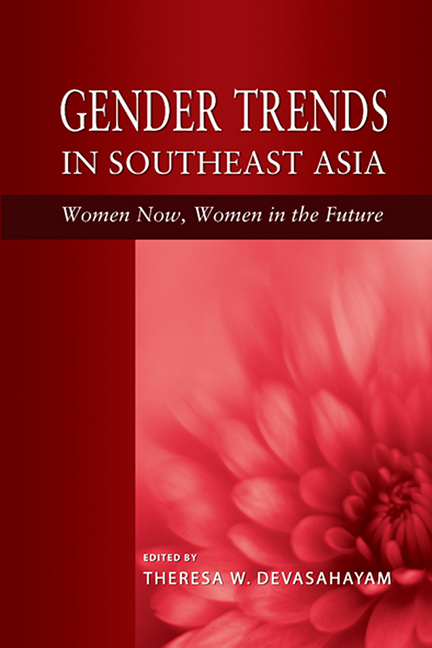Book contents
- Frontmatter
- Contents
- Contributors
- List of Tables and Figures
- Foreword
- Message
- Acknowledgements
- 1 Introduction: Women in Southeast Asia: Changes and Continuities
- 2 Women, Marriage and Family in Southeast Asia
- 3 Gender Trends in Migration and Employment in Southeast Asia
- 4 Has Gender Analysis been Mainstreamed in the Study of Southeast Asian Politics?
- 5 Gender Mainstreaming in Health: Mainstream or “Off-Stream”?
- 6 Politicization of Islam in Indonesia and Malaysia: Women's Rights and Inter-Religious Relations
- Index
2 - Women, Marriage and Family in Southeast Asia
Published online by Cambridge University Press: 21 October 2015
- Frontmatter
- Contents
- Contributors
- List of Tables and Figures
- Foreword
- Message
- Acknowledgements
- 1 Introduction: Women in Southeast Asia: Changes and Continuities
- 2 Women, Marriage and Family in Southeast Asia
- 3 Gender Trends in Migration and Employment in Southeast Asia
- 4 Has Gender Analysis been Mainstreamed in the Study of Southeast Asian Politics?
- 5 Gender Mainstreaming in Health: Mainstream or “Off-Stream”?
- 6 Politicization of Islam in Indonesia and Malaysia: Women's Rights and Inter-Religious Relations
- Index
Summary
INTRODUCTION
The main aim of this chapter is to look at changes in women's role in the family, in the face of dramatic contextual changes — globalization, economic growth, urbanization, educational development, and the increasing levels of workforce participation of women in urban areas. These have major effects on marriage — whether to marry, when to marry, whether child-raising can be combined with the demands of the workforce, and intra-family power structures.
The last half century has seen remarkable educational changes, from a situation of severe disadvantage for daughters in educational opportunity to one of near equality of opportunity, and indeed a female majority in tertiary education in a number of countries. What is remarkable is how universal these changes have been; what needs to be recognized is that they both contribute to, and are reflections of, changing attitudes to female roles.
More or less universally, the rising levels of education have made for increasing levels of female participation in the urban workforce. Although equality in incomes for equal work has not been achieved, the situation is much improved, and the excess of women in higher education means that many higher-status jobs are now going to women. Many women are also going abroad as migrant workers — more than two million Filipinas and one million Indonesians at any one time. Is this a reflection of broader opportunities opened up by education, or rather a reflection of the poor earning opportunities in the poorer countries of the region? It is no doubt both, but we should certainly keep in mind that even those going abroad as domestic servants from countries such as the Philippines and Indonesia typically have above average levels of education compared to others in their home areas.
A NOTE ON SOUTHEAST ASIAN FAMILY STRUCTURES
Before turning to the main theme of this chapter — the changing patterns of marriage and fertility in Southeast Asia and what they tell us about women's family roles — a general note on the Southeast Asian family may be in order.
- Type
- Chapter
- Information
- Gender Trends in Southeast AsiaWomen Now, Women in the Future, pp. 12 - 30Publisher: ISEAS–Yusof Ishak InstitutePrint publication year: 2009

